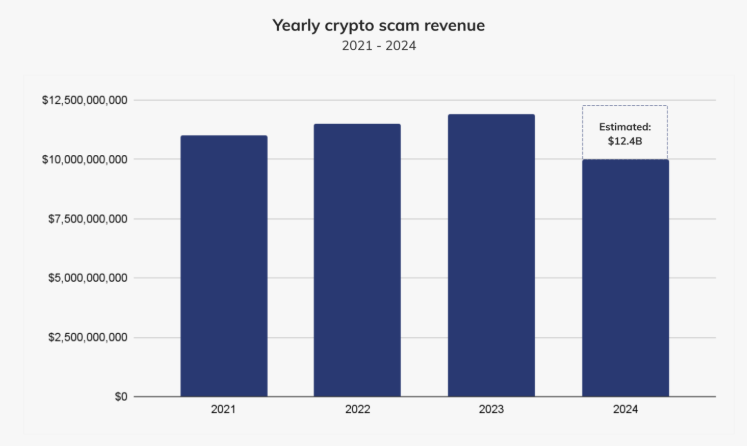-
Crypto scams generated $9.9 billion revenue in 2024, with pig butchering scams accounting for 33.2% of the total revenue.
-
Southeast Asia remains a hub for scams, with platforms like Huione Guarantee aiding fraud operations, including money laundering and data theft.
-
Fraud tactics like generative AI, crypto drainers, and ATM scams are on the rise, challenging law enforcement efforts to combat crypto crime.
A recent report by Chainalysis highlights an alarming rise in crypto scams, revealing a $9.9 billion revenue impact in 2024, with pig butchering scams leading the charge.
Chainalysis Reveals Growing Threat of Pig Butchering Scams
Chainalysis warns that the estimated $9.9 billion in scam revenue for 2024 is likely conservative. Instead, the final figures could potentially exceed $12 billion. The report highlights a near 40% increase in pig butchering incidences year over year, accounting for 33.2% of total crypto scam revenue.

Crypto Scam Revenue by Year. Source: Chainalysis
According to the report, many of these operations originate from Southeast Asia. Further, the report highlights scammers’ increasing sophistication, citing illicit services such as Huione Guarantee, a peer-to-peer (P2P) platform that facilitates fraud. Specifically, it is a Telegram-based marketplace serving Southeast Asian fraudsters, including those responsible for so-called pig butchering scams.
This platform provides scammers with money laundering tools, stolen personal data, and social media management services. Since 2021, Huione Guarantee has reportedly processed over $70 billion in crypto transactions, solidifying its role in the fraud ecosystem.
The research also revealed Huione Guarantee’s recent launches, USDH stablecoin and blockchain project Xone. These launches raised concerns about new avenues for fraudsters to obscure their transactions.
The report bolsters a recent incident in which Tether froze 29.62 million USDT linked to Cambodian criminal activities involving the Huione Group. Recently, Elliptic also exposed Huione Guarantee as a multi-billion dollar marketplace for online fraudsters.
Generative AI and Other Crypto Fraud Methods
Chainalysis also highlights the role of generative AI in enhancing scam tactics further, enabling fraudsters to impersonate victims. Specifically, it helps them bypass identity verification and create highly convincing fake investment platforms.
In addition to pig butchering scams and generative AI, other crypto fraud methods saw substantial growth in 2024:
- Address Poisoning: Scammers send small transactions from addresses, mimicking a victim’s contacts and tricking them into transferring funds to fraudulent wallets.
- Crypto Drainers: Phishing attacks increased by 170%, with incidents involving fake US Securities and Exchange Commission (SEC) airdrops.
- Livestream Scams & Sextortion: AI-generated deepfake scams and blackmail tactics have become more common.
- Employment Scams: Fraudsters impersonate legitimate companies, tricking victims into paying fraudulent training fees or tax deposits.
The use of cryptocurrency ATMs in scams has also surged. According to Chainalysis, the US FBI reported a tenfold increase in consumer losses since 2020. Fraudsters frequently exploit these ATMs to receive funds from victims who are convinced they are making legitimate payments.
“While crypto ATMs are used for legitimate purposes, they are also popular among scammers, and in the last few years, the FBI has received thousands of reports about cybercriminals using crypto ATMs to receive payouts for scams,” an excerpt in the report read.
Chainalysis also cites one case in which scammers deceived a US citizen into depositing $15,000 into Bitcoin ATMs under the pretense of fixing a computer virus. Authorities intervened, recovering part of the funds.
Based on these findings, Chainalysis acknowledges mounting challenges for law enforcement agencies in combating cryptocurrency fraud. While centralized exchanges (CEXs) remain the primary channel for laundering illicit funds, the rise of decentralized finance (DeFi) platforms complicates asset tracking.
Conclusion
The growing complexity and scale of crypto scams highlight a significant challenge in the digital asset landscape. As scams evolve, law enforcement remains in a perpetual race to develop more stringent and effective measures against such illicit activities. Investors and stakeholders must remain vigilant and prioritize safety in their crypto engagements to mitigate risks associated with emerging fraud tactics.
